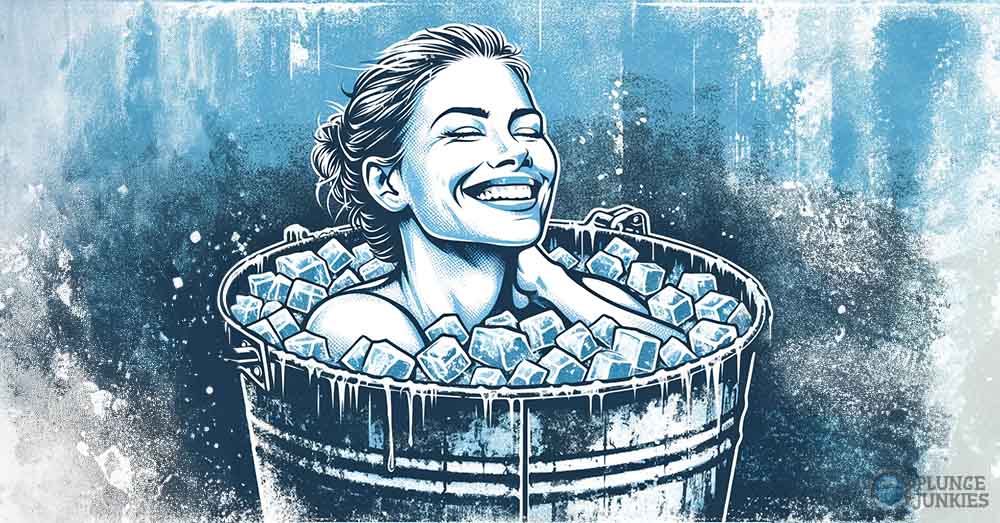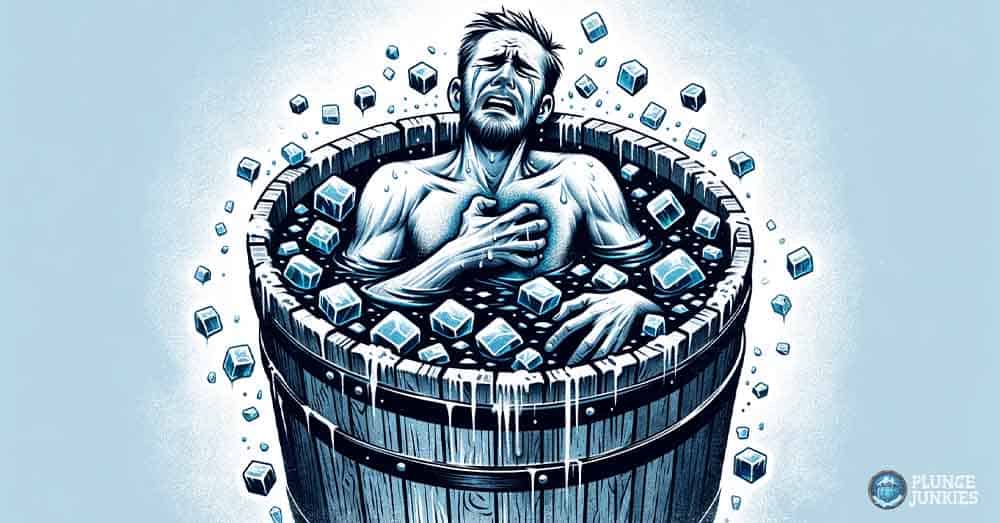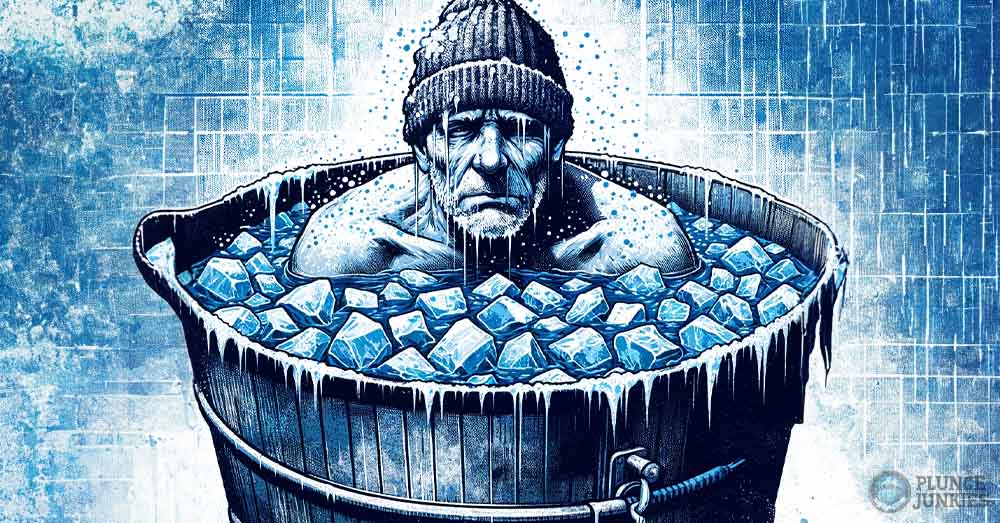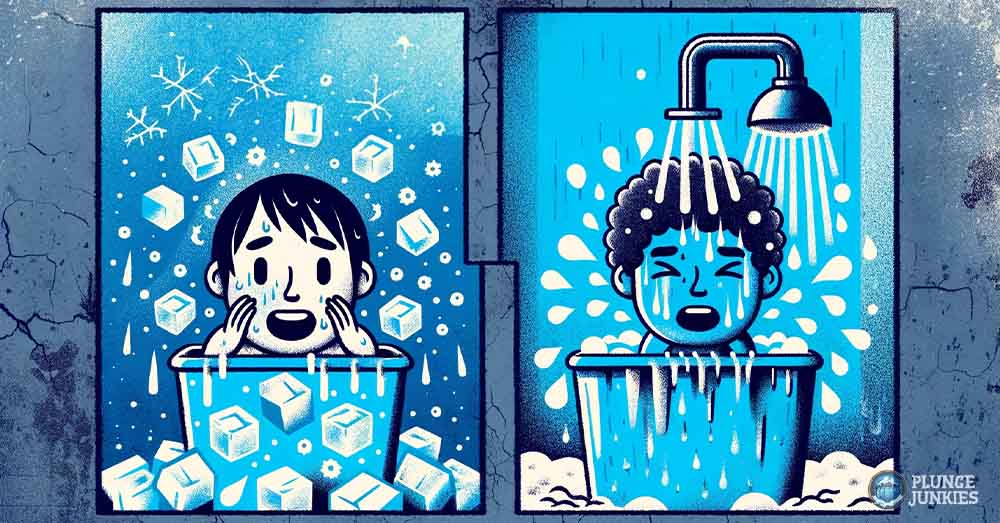Cold plunges, an age-old practice now backed by modern research, have emerged as a subject of debate in the wellness community, particularly regarding their use during illness.
Research suggests that a cold plunge or ice bath can offer benefits when sick, such as boosting immune function, relieving symptoms, and improving mood and sleep quality. However, they also pose risks, including hypothermia, cardiovascular stress, and immune system overload. It’s advisable for individuals with pre-existing health conditions, the elderly, and children to avoid them.
In this article, we will explore the potential benefits and risks of cold plunging when sick. We’ll look at how it can boost immune function, relieve symptoms, and improve factors like detoxification and nasal congestion. However, we’ll also examine its dangers, such as cardiovascular stress, overstimulating the immune system, and even how it can worsen symptoms.
Later sections will cover who should avoid cold plunging when sick, whether it can actually make you sick, and how it impacts specific illnesses, such as the flu or a fever. We’ll also compare cold plunging to cold showers when sick and how to begin your ice bath journey. By the end, you’ll have a balanced perspective on using cold water therapy during times of sickness.
Let’s plunge in!
11 Benefits of Cold Plunges When Sick

Although the thought of plunging into icy waters might send shivers down your spine, especially when unwell, evidence indicates that controlled cold water exposure can unlock a host of benefits, potentially aiding in quicker recovery.
Let’s explore 11 potential ice plunge benefits when sick, including how they can boost immune function, relieve symptoms, and improve factors like sleep quality and mood.
1. Boosts Immune Function
A cold bath could be just the thing to give your immune system a real boost, kick-starting white blood cell production and sparking those vital anti-inflammatory cytokines that help us fight off germs.
When you hit the cold, your body goes into a mini panic mode — think fight or flight. This rush pumps out hormones like noradrenaline that wake up your immune cells.
After taking a dip in cold water, research [1] has shown that there’s a boost in your white blood cells like lymphocytes, monocytes, and neutrophils, along with an increase in defensive proteins called cytokines such as IL-6. These are essential components of the immune system and play crucial roles in defending the body against infections and maintaining overall health.
2. Relieves Symptoms
Ice baths offer significant relief from symptoms associated with illness, primarily by reducing inflammation and pain. The cold causes blood vessels to constrict (vasoconstriction), limiting blood flow to inflamed areas, thus alleviating swelling and discomfort.
This constriction also moderates the production of pro-inflammatory cytokines, which, while crucial to the immune response, can cause tissue damage if overproduced. Ice baths help keep inflammation in check, so your immune system doesn’t go overboard and start damaging healthy tissue.

Additionally, the cold can numb nerve endings, diminishing the perception of pain. This numbing sensation, coupled with the sensory distraction and pain signal blockage, can give a quick break from headaches, muscle discomfort, and other body pains.
It’s crucial, however, to balance the anti-inflammatory benefits with the body’s need for an inflammatory response to combat infections, favoring gradual and controlled exposure over sudden, extreme cold.
3. Helps With Nasal Congestion
Regular cold plunges or ice baths can effectively alleviate nasal congestion and stuffiness, commonly experienced during colds or flu.
The cold induces vasoconstriction in nasal blood vessels, reducing swelling and congestion by shrinking swollen nasal membranes. This constriction opens up nasal airways and sinuses, facilitating better mucus drainage and clearer breathing.
Additionally, evidence suggests that regular cold water immersion may strengthen immune responses and decrease respiratory infections that cause congestion [2].
To take it further, switching between hot and cold water, known as contrast hydrotherapy, can kickstart circulation and help clear your nose by draining mucus.
4. Improves Sleep Quality
Ice baths, taken a few hours before bedtime, can significantly improve sleep quality, which is crucial for recovery during illness. They lower the body’s core temperature, aligning with the natural decrease in temperature that initiates sleep.
Scientific research, including a 2018 study [3], highlights that brief cold exposure increases melatonin levels in the blood, a hormone vital for sleep regulation.

Additionally, cold exposure can elevate mood-enhancing neurotransmitters like dopamine and serotonin, leading to reduced sleep latency and enhanced sleep quality.
Therefore, an ice bath taken 1-2 hours before bed, leveraging these natural bodily responses, can be an effective way to ensure restorative sleep, particularly when combating an illness.
5. Stimulates Lymphatic Drainage
Cold plunges can substantially stimulate the lymphatic system, a key component in the body’s immune response and fluid balance. This system, a network of vessels and nodes, shuttles lymph fluid loaded with infection-fighting white blood cells and antibodies.
When exposed to cold, your blood vessels constrict, and this jump-starts your lymphatic system, allowing it to move lymph fluid more efficiently and ramp up the fight against infections.
This improved flow efficiently circulates immune cells to areas needing defense, mobilizes damaged cells, and removes toxic byproducts of infection, aiding in reducing illness severity and duration.
Research, including studies [5] with water at 1 °C (34 °F), demonstrates that cold water can significantly increase lymph flow. This is beneficial not only for general immune support but also for those with health conditions involving inflammation or fluid retention.
6. Improves Mood
When taken during illness, ice baths can improve mood and emotions by triggering a surge in mood-enhancing neurochemicals.
Research indicates that exposure to cold activates the sympathetic nervous system, significantly increasing dopamine and endorphin levels, which are known for boosting mood.

A study [4] found that immersion in 57°F water raised noradrenaline and dopamine levels by 530% and 250%, respectively. These brain-boosting chemicals kick in, uplifting mood and alertness, acting as a lifeline when you’re bogged down by sickness and feelings of gloom.
Although an ice bath can be very uncomfortable at first, it helps take your mind off being sick and reduces stress.
7. Detoxification
Cold exposure can contribute to the body’s detoxification processes. This benefit extends beyond lymphatic drainage to include the liver and kidneys’ roles in filtering and eliminating waste from the blood.
Boosting your body’s detox game gets easier with cold exposure, as it ramps up circulation and helps us kick toxins to the curb more effectively.
Detoxification is especially important during illness, as the body produces additional waste and toxins while fighting off pathogens. A well-functioning detoxification system can aid in quicker recovery, as it helps in clearing these byproducts from the body.
8. Cold Shock Protein Activation
Engaging in cold plunges or ice baths stimulates the production of cold shock proteins (CSPs) in your body. These proteins are essential for strengthening your cells and helping your immune system function effectively, which is particularly useful when you’re sick, such as with a cold or the flu.
When you expose your body to cold temperatures for a short period, CSPs are activated. Their role is to help repair and stabilize cells that may be stressed by the cold environment. This support can enhance your body’s natural healing process, aiding in recovery during times of illness.

However, it’s important to understand that the benefits of CSPs are more aligned with long-term health and resilience. They don’t provide immediate relief from symptoms of sickness. Regular exposure to cold, such as through consistent ice baths, is more beneficial than occasional exposure.
The inner workings of how cold shock proteins (CSPs) give a boost to our immune system and help us shake off the flu is still something scientists are diligently digging into.
9. Enhances Circulation
Cold plunges enhance circulation, a vital factor for maintaining health, particularly during illness. Initially, cold exposure causes blood vessels to constrict, preserving core body heat.
This constriction is then followed by vasodilation, where vessels widen, allowing blood to rush to the surface. The swift back-and-forth between the narrowing and widening of blood vessels works like a pump, boosting the flow of blood all around your body.
Boosting your blood flow doesn’t just pump oxygen and nutrients around your body; it also delivers immune cells everywhere they need to go — a critical activity when you’re battling an infection.
Moreover, this whole system works overtime to get rid of all the nasty stuff your body makes when you’re unwell, helping you recover faster.
10. Accelerates Metabolic Rate
Cold plunges or ice baths accelerate the body’s metabolic rate, aiding recovery during illness. This metabolic boost occurs as the body works to maintain core temperature amidst the cold, leading to increased energy expenditure and a feeling of invigoration, beneficial for those feeling sluggish due to sickness.
Heightened metabolic activity facilitates quicker nutrient processing and cell regeneration. Cold exposure activates brown adipose tissue (BAT), triggering non-shivering thermogenesis, where energy is released to generate heat.

Studies, including a 2014 study on mice [6], show that this activation of BAT significantly boosts metabolism during exposure, with colder water inducing greater stimulation.
It’s important to accompany this increased metabolic demand with adequate nutrition and hydration, especially when using cold therapy during sickness.
11. Enhances Autonomic Nervous System Response
Cold water can positively impact the autonomic nervous system (ANS), which controls various involuntary bodily functions, including heart rate, digestion, and respiratory rate. Cold exposure can improve the balance between the sympathetic (fight or flight) and parasympathetic (rest and digest) responses of the ANS.
An enhanced ANS response means better regulation of stress hormones, improved digestion, and more controlled heart and respiratory rates. This can be particularly beneficial when sick, as a well-regulated ANS can help the body respond more effectively to the stresses of illness.
A 2008 study [7] looked at 10 male participants who spent time in both warm (25°C) and cold (10°C) environments for 2 hours a day for 10 days in a lab. The study found that after cold acclimation, there was a decrease in sympathetic activity, which is typically associated with the “fight or flight” response.
This suggests that individuals who are cold-acclimated might have a milder stress response when exposed to cold temperatures. Stress can weaken the immune system, so reduced stress from cold exposure might help maintain a stronger immune response.
While the benefits to the ANS are significant, they typically emerge from regular and controlled exposure to cold. Sudden or extreme cold exposure might be too stressful for the ANS, especially in individuals with pre-existing conditions that affect their nervous system.
The Risks Of Cold Plunges When Sick

While sick ice baths can be harmful, particularly if not done with caution. What might be a therapeutic practice under normal circumstances can become risky when the body is already fighting an illness.
Here are some of the risks to consider.
1. Hypothermia Risk
The human body, when sick, is already engaged in a high-energy battle against pathogens. This battle often involves fever, an immune response to fight infection.
Introducing the body to extreme cold, such as an ice bath, demands additional energy to maintain core temperature. If the body’s heat production can’t keep up with the loss, it leads to hypothermia.
This state can be especially dangerous if your body’s energy reserves are already depleted by illness.
2. Cardiovascular Stress
The cardiovascular system, comprising the heart and blood vessels, responds to cold by constricting peripheral blood vessels (vasoconstriction). This mechanism is meant to reduce heat loss but also increases blood pressure and heart rate.

If you’re grappling with heart problems or high blood pressure, this extra load can be hazardous, possibly leading to severe events like strokes or heart attacks when your body is already struggling against illness.
3. Immune System Overload
The immune system operates best under optimal conditions. Mild stressors, like moderate colds, can sometimes stimulate the immune response.
However, extreme cold, such as from an ice bath, can be an excessive stressor, tipping the balance from beneficial stimulation to harmful overload. This can weaken the immune defenses, potentially exacerbating the illness.
4. Breathing Difficulties
Cold air and water can trigger respiratory responses, such as hyperventilation (rapid breathing) and bronchoconstriction (tightening of airways).

For individuals with pre-existing respiratory conditions, such as asthma, these responses can exacerbate breathing difficulties, making it harder to manage the illness.
5. Risk of Fainting
Cold shock, an immediate response to cold exposure, can cause a rapid increase in breathing rate and blood pressure, potentially leading to dizziness or fainting.
This is particularly risky if you’re alone, as fainting can lead to injuries. Additionally, if you’re already weakened by sickness, the likelihood of such incidents increases.
6. Worsening of Symptoms
Certain illnesses, particularly those involving fever or respiratory issues, may worsen with cold exposure. The body’s fever response is a strategic increase in body temperature to fight infection. By drastically lowering body temperature, an ice bath can interfere with this natural defense mechanism.
On top of that, cold exposure can irritate the respiratory tract, making a cough or breathing troubles worse if you’re dealing with a chest cold.
Who Should Avoid Cold Plunges When Sick?

When sick, certain individuals should avoid cold water exposure due to the potential risks they pose to their health. Here’s a breakdown of who should be cautious:
- Individuals with Cardiovascular Diseases: Those with heart conditions like coronary artery disease or arrhythmias should avoid cold exposure, as it can exacerbate these conditions.
- People with Hypertension: The vasoconstriction caused by cold can dangerously elevate blood pressure levels in those already suffering from hypertension.
- Those with Respiratory Illnesses: Conditions like asthma or COPD can be worsened by cold water exposure, making breathing more difficult.
- People with Immune Deficiencies: With already weakened immune systems, additional stress from cold exposure can be detrimental to their health.
- Elderly Individuals: Due to diminished thermoregulation and potential underlying health issues, the elderly are particularly vulnerable when sick.
- Children, Especially Infants: Their higher surface area to body mass ratio makes them more susceptible to rapid temperature changes, which can be dangerous when ill.
- People with Certain Neurological Disorders: Those with conditions like multiple sclerosis may have impaired temperature regulation, making cold exposure risky.
- Those with Fever: Cold exposure can interfere with the body’s natural infection-fighting mechanism, potentially prolonging illness.
- People Prone to Hypothermia: Conditions like hypothyroidism or certain medications increase susceptibility to hypothermia, making cold exposure particularly risky.
- Individuals Experiencing Severe Fatigue or Dehydration: Already weakened by illness, these individuals can face exacerbated conditions due to cold stress.
- Pregnant Women: Pregnancy alters the body’s normal responses to temperature changes and stress. Cold exposure while pregnant can pose risks to both the mother and the developing fetus, especially if it leads to hypothermia or significant cardiovascular stress.
In general, when you’re sick, it’s essential to listen to your body. If a cold water feels too stressful or exacerbates symptoms, it’s better to opt for a more comfortable, lukewarm alternative.
As always, if in doubt, consulting with a healthcare provider is always best before trying cold therapy.
Can Cold Plunge Make You Sick?

The age-old saying that you can get sick from cold water has often been a topic of debate. Yet, it’s becoming increasingly clear from research that routine icy plunges or ice baths can beef up your immune system and possibly fend off colds.
A significant study conducted in the Netherlands [8] discovered that engaging in daily cold water exposure resulted in a 29% reduction in sick days compared to those not practicing cold immersion. When you plunge into icy water, it triggers your body to release a surge of white blood cells and antibodies, giving your immune system a real kick-start.
Similarly, a study [9] from the Czech Republic observed that consistent cold water immersion over a period of 6 weeks enhanced the count and activity of immune cells in young men.
The abrupt shock of cold on the body appears to activate its defensive mechanisms. Beyond just stimulating white blood cells, cold water exposure may ward off illness by boosting metabolism, improving circulation, and providing anti-inflammatory benefits.
Although we still need more research to fully get the picture, all signs point to the fact that regularly taking a quick dip in cold water could help ramp up our natural defenses and decrease our chances of getting sick.
Overall, an ice bath routine can help keep the sniffles at bay.
How Cold Plunges Affect Specific Illnesses
Do Cold Plunges Help the Flu?
Cold plunges and ice baths do not help with the flu. When exposed to extreme cold temperatures, the body’s initial reaction is to constrict blood vessels in the skin, which might temporarily lower skin temperature.
However, this can lead to an increase in core body temperature as the body compensates for the cold. In the context of the flu, where fever is a common symptom, this reaction can be counterproductive.
Using cold plunges to lower a fever is not advisable. The abrupt temperature change imposed by a cold plunge can stress the immune system, which is already working overtime to combat the flu.
Instead of resorting to cold plunges, more gentle methods, such as a cool washrag on the forehead or a brisk shower, can be used to gradually reduce body temperature without overwhelming the immune system.

Is a Cold Plunge Good for a Headache?
A cold plunge can potentially be beneficial for certain types of headaches, but its effectiveness can vary depending on the nature of the headache and individual responses to cold exposure.
- Vasoconstriction: Immersion in cold water causes vasoconstriction, the narrowing of blood vessels. This effect can reduce blood flow and pressure around the head and neck, potentially alleviating headache pain, especially in cases of tension headaches.
- Stimulation of the Vagus Nerve: Cold exposure can stimulate the vagus nerve, which may trigger anti-inflammatory responses in the brain, offering relief from headache symptoms.
- Endorphin Release: The shock of the cold plunge can lead to the release of endorphins, the body’s natural painkillers, which might help in reducing the discomfort of a headache.
- Individual Variability: It’s important to note that individual responses to cold therapy can vary greatly. While some may find relief, others might experience an increase in headache symptoms, especially if prone to migraines or cold-triggered headaches.
- Caution and Gradual Approach: If trying a cold plunge for headache relief, it’s advisable to start with a shorter duration and not excessively cold temperatures. Pay attention to how your body reacts, and stop immediately if the headache worsens.
Can a Cold Plunge Help a Hangover?
A cold plunge might offer some relief from hangover symptoms, but it’s important to understand the mechanism and potential effects.
- Shock Response: Immersing in cold water triggers a shock response in the body, leading to increased alertness and a surge in adrenaline. This can temporarily alleviate feelings of grogginess or fatigue associated with a hangover.
- Endorphin Release: Cold exposure stimulates the release of endorphins, the body’s natural painkillers, which can help in reducing headache or muscle ache symptoms from a hangover.
- Improved Circulation: The cold plunge can enhance blood circulation, potentially aiding in the faster removal of toxins accumulated in the body due to alcohol consumption.
- Hydration Concerns: It’s crucial to remember that hydration is key in recovering from a hangover, and a cold plunge does not replace the need to rehydrate the body. In fact, it could potentially exacerbate dehydration if not careful.
- Not a Cure: While a cold plunge might provide temporary symptomatic relief, it does not address the root cause of a hangover, which is primarily due to dehydration and the toxic byproducts of alcohol metabolism.
For a closer look at the science behind this, see our full guide on cold plunges or ice baths for a hangover.
Cold Plunge vs Cold Shower: Which Is Better When Sick?

When considering whether a cold plunge or a cold shower is better when sick, it’s important to understand the differences in their impacts on the body and how these might interact with an already compromised immune system.
- Cold Plunges involves submerging the body in cold water, typically between 50-59 degrees Fahrenheit (10-15 degrees Celsius). This immersion triggers a more intense physiological response than a cold shower, with rapid changes in heart rate, blood pressure, and breathing rate. Although this may boost the immune system in healthy individuals, it can be overly stressful for those already ill.
- Cold Showers are milder, involving less intense water temperatures and partial body exposure. This results in less dramatic physiological changes. While they can stimulate the immune system, they do so more gently than cold plunges.
For someone who is already sick, a cold shower might be the safer and more tolerable option compared to a cold plunge.
In general, a cold shower when sick is a gentler approach to self-care and is often more beneficial than extreme ones like cold plunges.
How to Start Cold Plunging During Illness

When integrating cold plunge therapy into your routine while sick, it’s important to find an ideal balance that stimulates the immune system without over-stressing the body:
- Temperature Guidelines: The optimal temperature for a cold plunge when you’re feeling under the weather is between 50-59 degrees Fahrenheit (10-15 degrees Celsius). The cooler water can provide a gentle shock to the system, which can enhance immune function without being too extreme.
- Timing Your Plunges: The best time to take a cold plunge is generally in the morning, as it can help invigorate your body and mind for the day ahead. Alternatively, if you’re using cold therapy to improve sleep quality, consider an ice bath a few hours before bedtime instead.
- Duration Considerations: Start with shorter sessions—around 1-3 minutes—and gradually increase as your body adapts to the cold exposure. Always be mindful of how your body feels; if you experience intense discomfort or worsening symptoms, it’s better to cut the session short. See our How Long to Cold Plunge article to see the optimal length of cold water immersion for certain benefits backed by science.
- Regulating Temperature with a Water Chiller: To maintain consistent and safe water temperatures for your cold plunges, investing in an ice bath water chiller can be beneficial. This device allows you to control the water temperature precisely, ensuring that you can get all the benefits of cold therapy without risking a further dip in your health.
- Enhancing Your Cold Plunge Experience: If you want to ensure that your cold plunge therapy is as effective as possible while sick, make it a part of your routine. Regularly exposing yourself to the optimal temperature range can acclimate your body, improve your resistance to cold, and provide consistent health benefits.
At Plunge Junkies, we recognize the importance of a controlled and comfortable cold therapy experience, which is why we offer not only a diverse collection of cold plunge tanks but also the necessary accessories like chillers to customize your healing journey. Explore our range and find the perfect cold therapy solution tailored to your wellness needs.
Remember to consider your own health and comfort levels when starting cold plunge therapy during illness. By taking these tips into account and carefully monitoring your body’s reactions, you can enjoy the rejuvenating effects of cold plunges while aiding your recovery process.
References
- Janský L, Pospísilová D, Honzová S, Ulicný B, Srámek P, Zeman V, Kamínková J. Immune system of cold-exposed and cold-adapted humans. Eur J Appl Physiol Occup Physiol. 1996;72(5-6):445-50. doi: 10.1007/BF00242274. PMID: 8925815.
- Esperland D, de Weerd L, Mercer JB. Health effects of voluntary exposure to cold water – a continuing subject of debate. Int J Circumpolar Health. 2022 Dec;81(1):2111789. doi: 10.1080/22423982.2022.2111789. PMID: 36137565; PMCID: PMC9518606.
- Xu, Xiaoying et al. “Association of Melatonin Production with Seasonal Changes, Low Temperature, and Immuno-Responses in Hamsters.” Molecules (Basel, Switzerland) vol. 23,3 703. 20 Mar. 2018, doi:10.3390/molecules23030703
- Srámek P, Simecková M, Janský L, Savlíková J, Vybíral S. Human physiological responses to immersion into water of different temperatures. Eur J Appl Physiol. 2000 Mar;81(5):436-42. doi: 10.1007/s004210050065. PMID: 10751106.
- Meeusen R, van der Veen P, Joos E, Roeykens J, Bossuyt A, De Meirleir K. The influence of cold and compression on lymph flow at the ankle. Clin J Sport Med. 1998 Oct;8(4):266-71. doi: 10.1097/00042752-199810000-00003. PMID: 9884790.
- Kowaltowski, Alicia J. “Cold Exposure and the Metabolism of Mice, Men, and Other Wonderful Creatures.” Physiology (Bethesda, Md.) vol. 37,5 (2022): 0. doi:10.1152/physiol.00002.2022
- Mäkinen TM, Mäntysaari M, Pääkkönen T, Jokelainen J, Palinkas LA, Hassi J, Leppäluoto J, Tahvanainen K, Rintamäki H. Autonomic nervous function during whole-body cold exposure before and after cold acclimation. Aviat Space Environ Med. 2008 Sep;79(9):875-82. doi: 10.3357/asem.2235.2008. PMID: 18785356.
- Buijze GA, Sierevelt IN, van der Heijden BC, Dijkgraaf MG, Frings-Dresen MH. The Effect of Cold Showering on Health and Work: A Randomized Controlled Trial. PLoS One. 2016 Sep 15;11(9):e0161749. doi: 10.1371/journal.pone.0161749. Erratum in: PLoS One. 2018 Aug 2;13(8):e0201978. PMID: 27631616; PMCID: PMC5025014.
- Janský, L., Pospísilová, D., Honzová, S., Ulicný, B., Srámek, P., Zeman, V., & Kamínková, J. (1996). Immune system of cold-exposed and cold-adapted humans. European journal of applied physiology and occupational physiology, 72(5-6), 445–450. https://doi.org/10.1007/BF00242274







